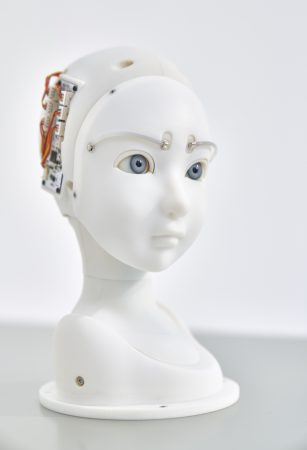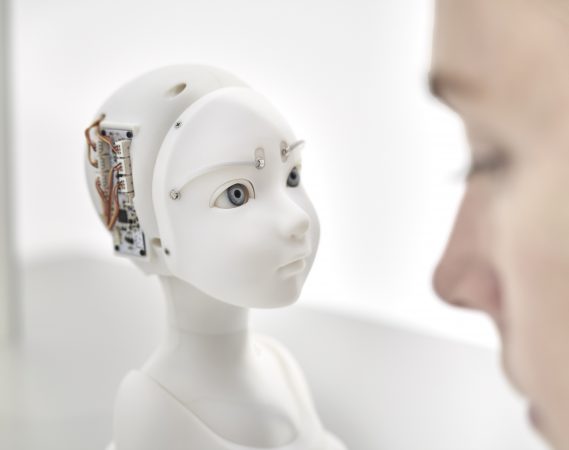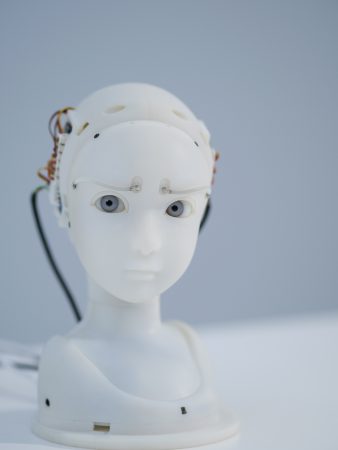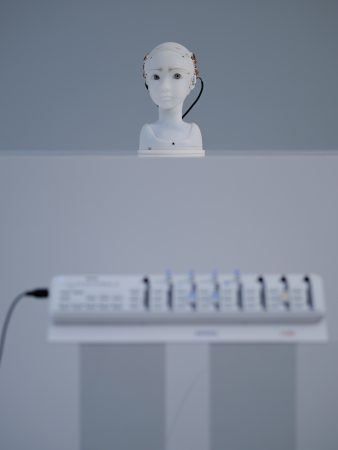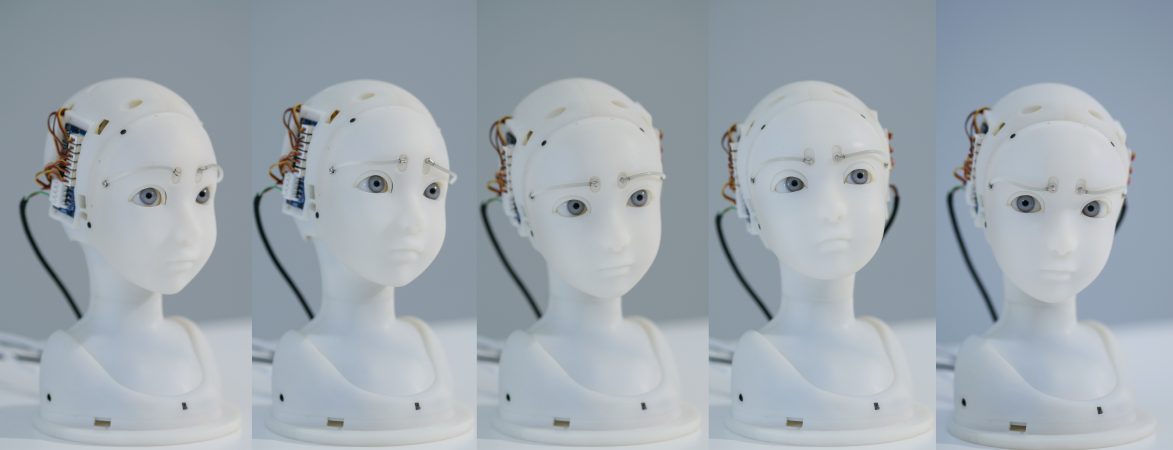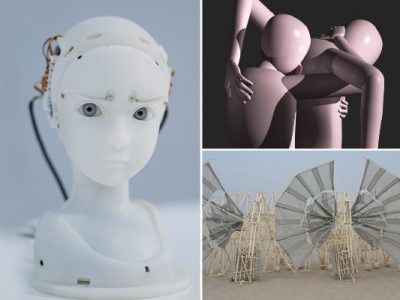Takayuki Todo
Empathic Systems
14.06.2019 — 08.09.2019
Opening: Thursday, June 13, 2019 at 7pm
The Frankfurter Kunstverein has invited Yves Netzhammer, Theo Jansen, and Takayuki Todo to present a selection of their works in solo shows, under the shared thematic title “Empathic Systems.”
“SEER” is a humanoid robotic head developed as an artistic work by Takayuki Todo. It explores the significance of gaze and facial expression in the sphere of human-machine research.
The art of hyperrealistic sculpture has existed for over 4000 years. Sculptors from different stylistic eras consistently aimed to reproduce reality as vividly as possible. Classical art sought to breathe life into a figure, whether as an archetypal symbol or the portrait of an individual. To this end, artists developed methods and used stylistic devices to capture what renders a being alive in an image: the gaze. The gaze is a central feature of the individual expression of mental states. Eye contact is one of the strongest forms of communication between two beings, one of the most elemental forms of (visual) connection. It takes place beyond language and creates a direct exchange between two individuals – who do not necessarily have to be human. Eye contact represents a mutual perception by the living, who recognize each other in their aliveness. Through their subjects’ gaze, sculpture, painting, photography, and cinematography try for a moment to override the separation between the here of the viewer and the there of the fictional figure.
Takayuki Todo is interested in how people establish an emotional relationship with humanoid robots. As the discipline of robotics has shown for years, a realistic similarity to the human form alone is not able to break down the distance between a human and a machine. The term “uncanny valley” refers to this very narrow but significant gap between what a person perceives as real and credible, and what they perceive as artificial and uncanny.
For Todo, the central element that offers a way out of the “uncanny valley” is the gaze. For years he has been working on anthropomorphic figures that are made of entirely synthetic materials yet acquire a liveliness through their gaze. Created in 2018, Todo calls his “Simulative Emotional Expression Robot” “SEER” – evocative of a seeing being. Using a 3D printer, the artist produced a head made of several parts that was designed on a reduced scale and without any gender or ethnicity-specific features.
The robot has a camera that perceives the human counterpart, focuses, and then reciprocates their gaze. “SEER” not only interacts with the viewer through eye contact, but also by nodding its head and moving its eyes, eyelids, and eyebrows. The intensity of the movements increases as the person approaches “SEER”. The figure has a childlike physiognomy, its facial expressions and movements are comforting in their tenderness. “SEER” seems to have a life of its own in which it encounters us. It reflects the facial expressions of its counterpart, it generates movements as reproductions of existing ones, but does not produce any autonomous gestures.
Its mouth and lips are entirely motionless. On the robotic head one can see the cables and motors, the surface is bare and not concealed by a hair prosthesis, as with some humanoid machines. Todo makes no secret of the technical, synthetic nature of “SEER”; he deliberately maintains its artificial appearance. On the other hand, the eyebrows are made of soft elastic plastic that mean the robot’s expression appears lifelike, as if it could feel emotions. The softness of movement and most importantly, the eye contact, create an immediate empathic connection to the machine for the viewer.
The human emotional system is easily misled into recognizing human-like traits in machine behavior. The issue of the interface and thus the emulation of physical characteristics is of central importance here. Science fiction films such as “Her” (Spike Jonze, 2013) or “Ex Machina” (Alex Garland, 2014) have exemplified the important role anthropomorphic traits play as the interface of artificial intelligence. The sound of the voice in “Her”, or the gaze, skin texture, and semblance of a young female body in “Ex Machina” create the desire in humans for a connection with the machine being. Using only a few methods, humans can be deluded into emotionally removing the difference—which they are intellectually aware of—between them and the machine. Referred to in computer science as the ELIZA effect, this is the susceptibility of human beings to read significantly more intellect into a computer’s order of symbols than is actually there.
“The purpose of my research and development is not the answer to the philosophical issue ‘Will a robot (or computer) acquire intellect or emotions like humankind?’, but the representation of conscious emotions that a human can produce.”
(Takyuki Todo)
Contributors
Programming: Takanari Miisho
Wiring and electronics design: Yuki Koyama
About the exhibition “Empathic Systems”
The Frankfurter Kunstverein has invited Yves Netzhammer, Theo Jansen, and Takayuki Todo to present a selection of their works in solo shows, under the shared thematic title “Empathic Systems.”
The works of the three artists use varying aesthetics and result from completely different artistic processes. Nonetheless, all the works share a corporeal appearance despite being synthetically made. They are capable of touching the viewer solely through the form of their physical activity in space, beyond any recognizable linguistic conceptualization.
The exhibition revolves around the complex emotional relationship between humans and technology. Communication processes no longer only happen from human to human, but between humans and technology. Digital technologies are also increasingly exchanging data solely between each other.
Yves Netzhammer’s artistic oeuvre offers an examination of the central issues of being human in the digital age. His humanoid figures are reminiscent of anatomical puppets, devoid of any individual traits or facial expressions. Through them, Netzhammer formulates metaphors that translate the spectrum of human emotions into images. In a sequence of gestures and moments, he creates moods that the viewer knows how to decode, should they be willing to empathize and feel on behalf of the figures. Netzhammer’s figures define themselves through interaction with their environment. The reduced arrangements result in dense scenes where individual interaction processes take place that act as syntheses of human action and feeling. He extracts the essence of human experience and uses digital drawing and programming techniques to create animations that evoke empathetic reactions in the viewer. Netzhammer occupies three floors of the Frankfurter Kunstverein with a selection of his digital animated films, graphic works, and new kinetic installations.
Theo Jansen creates expansive kinetic sculptures and describes them as a new form of non-biological life. He builds the sculptures from synthetic materials such as polyurethane tubes, cable ties, and plastic bottles. The creatures he constructs are then are set in motion by wind, building up kinetic energy to start moving. Via a computer program that Jansen developed, an algorithm calculates the mechanics of the walking apparatus. The supporting skeleton is constructed in precise proportions. This creates flowing, insect-like movements that have an immediate effect on the viewer. The empathic relation to the creatures is not established by their face, anthropomorphic traits, or an expression, but rather their movements in space.
With his work “SEER,” Takayuki Todo explores the emotional effect of eye contact and facial expressions in the interaction between humans and technology. Using 3D printing modules, miniature motors, and facial recognition software, Todo has created an anthropomorphic head that seeks the viewer’s gaze, reciprocates it, and mirrors their facial expression. The minimal movements create an immediate synchronization of the gestures and facial expressions between human and humanoid, as well as an emotional reaction in the viewer. An asymmetry in the interaction emerges. For the viewer, the machine’s behavior seems like an expression of emotions. What the technical body accomplishes is the deconstruction and reproduction of the human gaze and the movements of the face’s surface. Though the viewer projects human intentions onto the machine, they are essentially looking at a reflection of themselves.
All three artists work at the intersection of engineering and computer science with psychology, cognitive science, neuroscience, and ethics. They bring together a variety of technical, artistic, and psychological principles. The works elicit a level of feeling in the human viewer that is not always linguistically graspable, but instead appeals to an empathic sensitivity. In a number of ways, their artificial apparatuses become mirrors viewers encounter and recognize themselves in: sometimes in their doubling, sometimes in their distortion.
Humans and machines differ substantially in the sensory apparatuses they use to perceive and understand the world. Recognizing things begins by grasping them sensorially. Humans experience and understand the world through their body and their sense organs. In doing so they create their interpretation of the world in the form of cognizance. The body is the medium for human being-in-the-world. It acts as the link between humans and the world, or between subject and object. It belongs to the ego and the world at the same time, it is subject and object in one. Technology does not have this corporeality.
Today’s state-of-the-art computer science has produced programs and algorithms that generate machine-specific knowledge through data sets and associated information. The ways that humans and machines generate knowledge and their consequent actions are still different. But the questions remains whether this gap narrow in the future.
Although there is neither a unified theory of emotions in the natural and behavioral sciences nor a definition that is accepted across the disciplines, interdisciplinary research projects are investigating different methods of increasing the human emotional response to digital agents under the heading of “Affective Computing.” Numerous industrial sectors have a great interest in recognizing emotional systems in order to use them for the development of machine learning and artificial intelligence. Functions should sound and look “more human,” thus minimizing the difference between human feeling towards technology as opposed to other humans.
For the most part, human beings can only recognize emotional signals and signs on the basis of physical characteristics. As such researchers are working to ensure that speech interfaces, talking robots, or humanoid nursing assistants, for example, are designed accordingly. Interfaces are being developed that implement knowledge about the meaning of emotional states and moods.
Research into emotions is thus gaining an increasingly central role in the research and development of artificial intelligence. Technologies are being used that examine users’ moods and their emotional reactions to content. Systematized knowledge about feelings, emotions, sensations, as well as moods, perspectives, and intentions is already being implemented in a targeted manner. So-called “online sentiment analysis” is being conducted, namely algorithmic tests that classify all content according to whether it was created with a subliminal positive or negative sentiment. Each author’s content and attitudes are evaluated. Political entities and commercial enterprises benefit from in-depth knowledge about the emotional responses of an individual, who is always also a user, consumer, patient, citizen, and thus part of an overall social system. Digital assistants and systems are undergoing further development to the point their speech recognition not only understands what a human is saying, but also the emotional state they are in as they do so.
The question concerning the meaning of emotions and the gaze of the other is one of the eternal human issues that have played a central role in all of cultural history. The exhibitions at the Frankfurter Kunstverein seek to show and reflect the connection between contemporary art production and current social phenomena. The perspectives of the interdisciplinary research field of Affective Computing will have an impact on a wide-ranging social and political scale.
The exhibitions devoted to Yves Netzhammer, Theo Jansen, and Takayuki Todo offer a concentrated view of each of their artistic worlds and aesthetic formulations. The exhibitions function through spatial experiences in which viewers encounter the works physically and sensually.
Netzhammer’s works beguile visitors with their intense visual and acoustic power. Todo’s SEER requires the visitor to actively interact with the robot, stepping directly in front of it to establish an emotional connection through eye contact. Theo Jansen’s kinetic sculptures are animal creatures that visitors can set in motion with their own physical strength in a sandy landscape.
Art has the ability to make people pause, perhaps halt time for a moment, forget for a moment, and to marvel. In amazement there lies an existential force, a yearning for deeper knowledge, for an understanding of the inner workings, for what “it” is and how to grasp it. The artistic view of the world is restless, questioning, searching, and striving for forms of representability. It employs for metaphor in the search for knowledge. Those who follow this view can succeed in experiencing something new through feeling empathy with others and re-experiencing themselves in this realm. In this encounter, art can become a transformative force.
Curator: Franziska Nori

